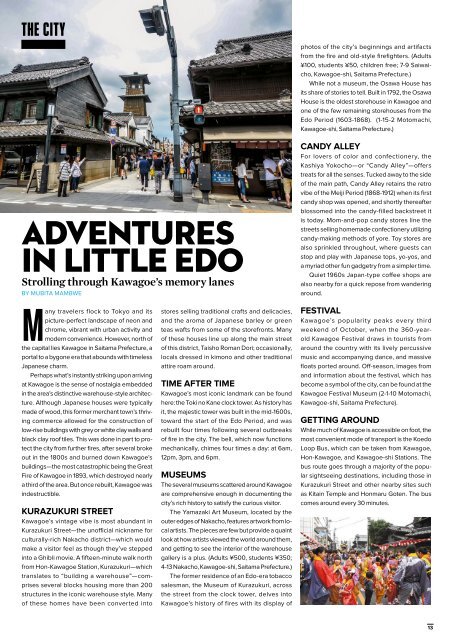DAVID BOWIE
metropolis-feb16
metropolis-feb16
Create successful ePaper yourself
Turn your PDF publications into a flip-book with our unique Google optimized e-Paper software.
THE CITY<br />
ADVENTURES<br />
IN LITTLE EDO<br />
Strolling through Kawagoe’s memory lanes<br />
BY MUBITA MAMBWE<br />
photos of the city’s beginnings and artifacts<br />
from the fire and old-style firefighters. (Adults<br />
¥100, students ¥50, children free; 7-9 Saiwaicho,<br />
Kawagoe-shi, Saitama Prefecture.)<br />
While not a museum, the Osawa House has<br />
its share of stories to tell. Built in 1792, the Osawa<br />
House is the oldest storehouse in Kawagoe and<br />
one of the few remaining storehouses from the<br />
Edo Period (1603-1868). (1-15-2 Motomachi,<br />
Kawagoe-shi, Saitama Prefecture.)<br />
CANDY ALLEY<br />
For lovers of color and confectionery, the<br />
Kashiya Yokocho—or “Candy Alley”—offers<br />
treats for all the senses. Tucked away to the side<br />
of the main path, Candy Alley retains the retro<br />
vibe of the Meiji Period (1868-1912) when its first<br />
candy shop was opened, and shortly thereafter<br />
blossomed into the candy-filled backstreet it<br />
is today. Mom-and-pop candy stores line the<br />
streets selling homemade confectionery utilizing<br />
candy-making methods of yore. Toy stores are<br />
also sprinkled throughout, where guests can<br />
stop and play with Japanese tops, yo-yos, and<br />
a myriad other fun gadgetry from a simpler time.<br />
Quiet 1960s Japan-type coffee shops are<br />
also nearby for a quick repose from wandering<br />
around.<br />
Many travelers flock to Tokyo and its<br />
picture-perfect landscape of neon and<br />
chrome, vibrant with urban activity and<br />
modern convenience. However, north of<br />
the capital lies Kawagoe in Saitama Prefecture, a<br />
portal to a bygone era that abounds with timeless<br />
Japanese charm.<br />
Perhaps what’s instantly striking upon arriving<br />
at Kawagoe is the sense of nostalgia embedded<br />
in the area’s distinctive warehouse-style architecture.<br />
Although Japanese houses were typically<br />
made of wood, this former merchant town’s thriving<br />
commerce allowed for the construction of<br />
low-rise buildings with grey or white clay walls and<br />
black clay roof tiles. This was done in part to protect<br />
the city from further fires, after several broke<br />
out in the 1800s and burned down Kawagoe’s<br />
buildings—the most catastrophic being the Great<br />
Fire of Kawagoe in 1893, which destroyed nearly<br />
a third of the area. But once rebuilt, Kawagoe was<br />
indestructible.<br />
KURAZUKURI STREET<br />
Kawagoe’s vintage vibe is most abundant in<br />
Kurazukuri Street—the unofficial nickname for<br />
culturally-rich Nakacho district—which would<br />
make a visitor feel as though they’ve stepped<br />
into a Ghibli movie. A fifteen-minute walk north<br />
from Hon-Kawagoe Station, Kurazukuri—which<br />
translates to “building a warehouse”—comprises<br />
several blocks housing more than 200<br />
structures in the iconic warehouse style. Many<br />
of these homes have been converted into<br />
stores selling traditional crafts and delicacies,<br />
and the aroma of Japanese barley or green<br />
teas wafts from some of the storefronts. Many<br />
of these houses line up along the main street<br />
of this district, Taisho Roman Dori; occasionally,<br />
locals dressed in kimono and other traditional<br />
attire roam around.<br />
TIME AFTER TIME<br />
Kawagoe’s most iconic landmark can be found<br />
here: the Toki no Kane clock tower. As history has<br />
it, the majestic tower was built in the mid-1600s,<br />
toward the start of the Edo Period, and was<br />
rebuilt four times following several outbreaks<br />
of fire in the city. The bell, which now functions<br />
mechanically, chimes four times a day: at 6am,<br />
12pm, 3pm, and 6pm.<br />
MUSEUMS<br />
The several museums scattered around Kawagoe<br />
are comprehensive enough in documenting the<br />
city’s rich history to satisfy the curious visitor.<br />
The Yamazaki Art Museum, located by the<br />
outer edges of Nakacho, features artwork from local<br />
artists. The pieces are few but provide a quaint<br />
look at how artists viewed the world around them,<br />
and getting to see the interior of the warehouse<br />
gallery is a plus. (Adults ¥500, students ¥350;<br />
4-13 Nakacho, Kawagoe-shi, Saitama Prefecture.)<br />
The former residence of an Edo-era tobacco<br />
salesman, the Museum of Kurazukuri, across<br />
the street from the clock tower, delves into<br />
Kawagoe’s history of fires with its display of<br />
FESTIVAL<br />
Kawagoe’s popularity peaks every third<br />
weekend of October, when the 360-yearold<br />
Kawagoe Festival draws in tourists from<br />
around the country with its lively percussive<br />
music and accompanying dance, and massive<br />
floats ported around. Off-season, images from<br />
and information about the festival, which has<br />
become a symbol of the city, can be found at the<br />
Kawagoe Festival Museum (2-1-10 Motomachi,<br />
Kawagoe-shi, Saitama Prefecture).<br />
GETTING AROUND<br />
While much of Kawagoe is accessible on foot, the<br />
most convenient mode of transport is the Koedo<br />
Loop Bus, which can be taken from Kawagoe,<br />
Hon-Kawagoe, and Kawagoe-shi Stations. The<br />
bus route goes through a majority of the popular<br />
sightseeing destinations, including those in<br />
Kurazukuri Street and other nearby sites such<br />
as Kitain Temple and Honmaru Goten. The bus<br />
comes around every 30 minutes.<br />
13


